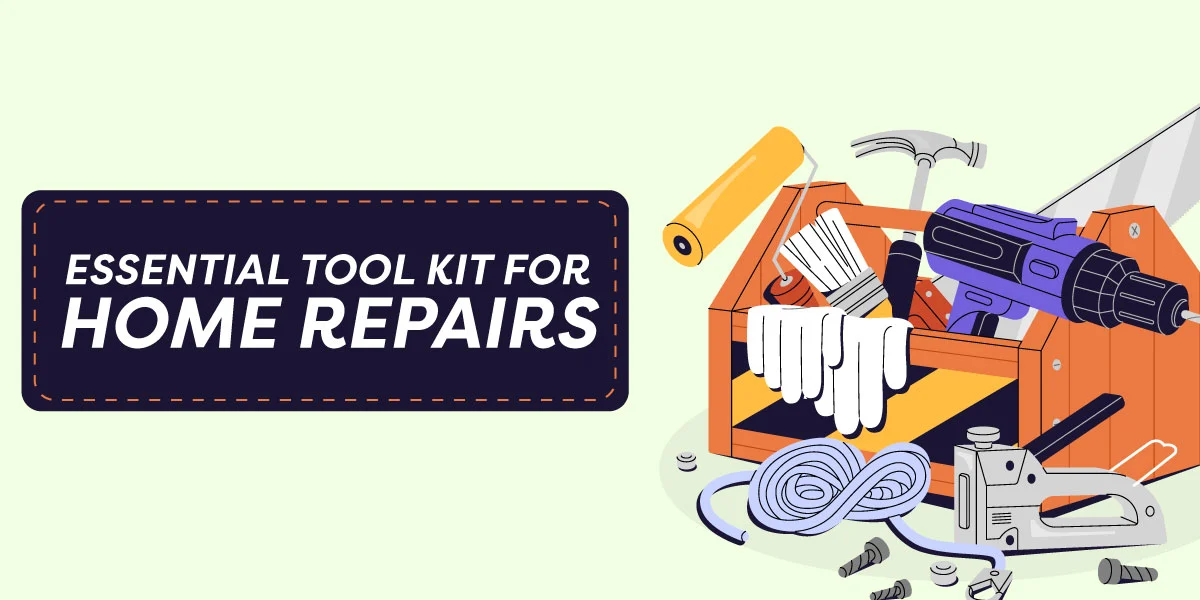Maybe you have a door that sticks, a leaky faucet, or a loose cabinet handle. Who you gonna call?
Ghostbusters don’t do home repairs, and they’re far from affordable. And it would be overkill to hire the plumber for something as piddling as a running toilet.
As a homeowner, you’ll need a war chest of tools for simple DIY repairs — unless you enjoy shelling out for every little thing that goes wrong and waiting half the day for help to arrive.
The Tools Every Homeowner Should Have
Whether you’re hanging a picture frame or tightening a loose screw, these are the tools for most DIY projects.
Hammer
A hammer’s simple design belies its utility. Most homeowners already have one, but it belongs on the list all the same.
Common DIY Tasks Requiring a Hammer
- Hanging pictures and wall decor
- Assembling furniture.
- Constructing shelves and decks or fixing loose wooden planks
- Installing molding or trim
- Minor demolition work, like removing old fixtures or tiles
- Tacking down loose floorboards
- Reattaching or replacing wooden fence panels
Saws
The right saw can improve the ease and finish of your work, enabling precise cuts that enhance aesthetics and structural integrity.

Cutting boards with a jigsaw.
Types of Saws for DIY Projects
- Hand Saw: For basic tasks like cutting lumber or trimming tree branches.
- Circular Saw: A power tool for making straight cuts through wood, plastic, and metal.
- Jigsaw: Perfect for curved or intricate cuts in various materials.
- Miter Saw: Ideal for the precise angle cuts of framing and molding.
- Reciprocating Saw: Best for demolition projects, capable of cutting through wood, metal, and plastic.
- Table Saw: Useful for making the long, straight cuts of larger construction projects.
Common DIY Tasks Requiring a Saw
- Cutting lumber for projects like decks, benches, or birdhouses
- Trimming doors or windows that don’t fit their frames perfectly
- Sawing through metal pipes or bolts during plumbing projects
- Cutting paneling, molding, or tiles for home renovation projects
- Crafting wooden or metal pieces for furniture
Screwdrivers with Interchangeable Heads
Interchangeable heads, including Phillips, flathead, and Torx, expand the usefulness of a screwdriver. You might buy one screwdriver for larger screws and another for the tiny screws of electronic devices.
Common DIY Tasks Requiring a Screwdriver
- Tightening or loosening screws on furniture, appliances, or electronic devices
- Opening paint cans or prying out small nails
- Adjusting door hinges to ensure smooth opening and closing
- Replacing light switch covers or electrical outlets
- Assembling DIY furniture kits or children’s toys
- Maintenance tasks on HVAC systems and air vents
Power Drill & Bits
Nothing beats a power drill for boring holes in walls, wood, metal, or plastic, and it can drive screws into tough materials that hinder a screwdriver. Cordless models offer convenient portability.
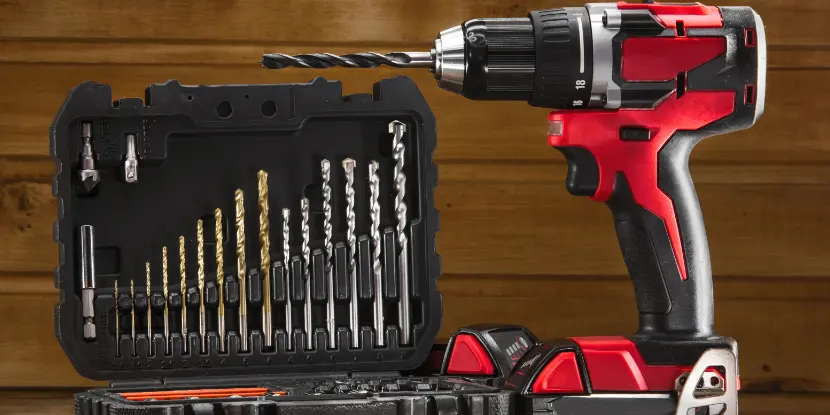
A cordless drill and drillbit set.
Types of Drill Bits for DIY Projects
- Twist bits for general-purpose drilling in wood, plastic, and light metals
- Masonry bits for drilling through brick or concrete
- Spade bits for making larger holes in wood
- Hole saws for cutting large holes in wood, plastic, and metal
- Screwdriver bits for driving screws into different materials
Common DIY Tasks Requiring a Power Drill
- Boring pilot holes in wood before inserting screws or nails
- Drilling holes to install shelves, hooks, or curtain rods
- Installing anchors and bolts in masonry walls for heavy objects like shelves or mirrors
- Assembling furniture or cabinets
- Replacing doorknobs, locks, or hinges
- Building wooden decks or fencing
Pliers
Pliers do more than grip. They cut, strip, and twist wires and make tasks involving small or stubborn parts much easier than with hands alone. Having various sizes and types of pliers in your tool kit will save you time and frustration.
Common DIY Tasks Requiring Pliers
- Cutting or stripping wires for small electrical projects
- Bending or shaping wires for electronic repairs
- Repairing jewelry, eyeglasses, or small mechanical parts
- Gripping nails to remove them from walls or furniture
- Tightening nuts and bolts too small for fingers to turn
- Holding small objects securely while working on them, such as screws, nails, or jewelry
Adjustable Wrenches
Adjustable wrenches are indispensable for plumbing, assembly, and maintenance tasks. They open and close to fit nuts, bolts, and pipes of various sizes.
- Crescent wrenches are perfect for tight spaces and turning fasteners.
- Channellocks, or tongue-and-groove pliers, offer a robust grip for plumbing tasks, like tightening or loosening pipe fittings.
- Locking wrenches, or vise grips, have adjustable jaws that lock in place. This provides a firm grip for stubborn bolts or holds objects securely while working on them.
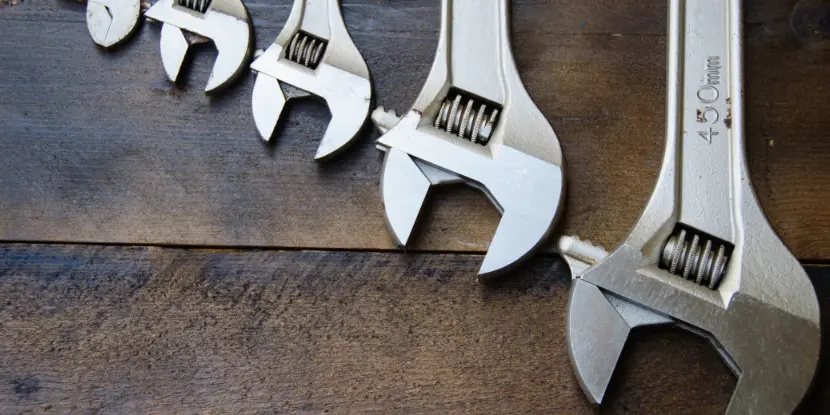
Various sizes of Crescent wrenches.
Common DIY Tasks Requiring Wrenches
- Tightening or loosening pipes during plumbing repairs
- Working on automotive parts for maintenance or repairs
- Assembling furniture or equipment with bolted connections
- Adjusting or repairing bicycles
- Tightening bolts and nuts in metal constructions like grills or shelves
- Securing fasteners on appliances and home systems
Hex Wrench Set
Hex wrenches, or Allen keys, are simple, compact tools that fit the hexagonal sockets of modern furniture, bicycles, etc. A wrench set gives you the flexibility to work on a range of hex-head screws and bolts.
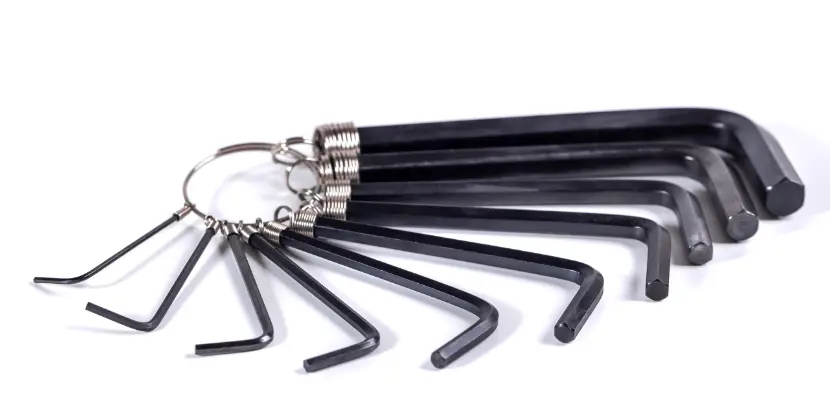
A hex wrench set.
Common DIY Tasks Requiring Hex Wrenches
- Assembling flat-pack furniture, such as desks, chairs, and beds
- Adjusting or repairing parts on bicycles and scooters
- Tightening loose hardware on workout equipment
- Making adjustments to door handles and cabinet knobs
- Disassembling items for repair or transport
- Working on electronic devices that use hex screws for assembly
Garbage Disposal Wrench
This specialized tool fits into a socket under the garbage disposal, providing the leverage to turn the masher plate and free objects causing blockages.
Another iteration of the disposal wrench works from the top via the sink drain and engages with the disposal’s turntable. Either way, an inexpensive disposal wrench can keep the plumber at bay and save you a heap of cash.
Retractable Tape Measure
You’ll need this for projects like installing shelves or cutting wood for a new deck. Accurate measurements mean the difference between a job well done and costly mistakes.
Common DIY Tasks Requiring a Tape Measure
- Measuring walls for hanging shelves or pictures
- Determining the size of windows for curtains or blinds
- Cutting materials like wood, fabric, or tile to precise dimensions
- Designing layouts for floor plans and furniture placement
- Estimating the size of rooms for remodeling or new furniture
- Installing cabinets and countertops in kitchens and bathrooms
- Building or repairing decks, fences, or shelving
- Creating patterns or designs for landscaping projects
Utility Knife
With replaceable blades that can be retracted for safety, this compact tool handles a multitude of materials, making it invaluable for quick cuts, trimming, and opening packages.
Common DIY Tasks Requiring a Utility Knife
- Trimming wallpaper or edges for painting projects
- Cutting cardboard, carpet, or vinyl flooring materials
- Opening boxes or cutting through packaging tape
- Scoring drywall for installation or repair
- Carving wood for detailed craft projects
- Stripping insulation from electrical wiring
- Cutting ropes and strings for gardening
- Customizing foam or other materials for protective storage
Spirit Level
A level is crucial for hanging frames, installing shelves, and laying floors to ensure smooth, professional outcomes.
While a smartphone app can replicate a level’s basic function, it won’t be as accurate as a spirit level or dedicated electronic level. A physical level is also more durable and reliable in rougher working conditions.
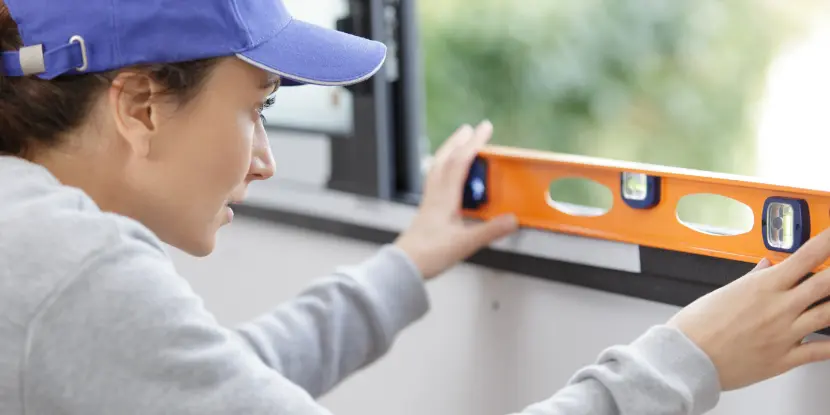
Checking a window frame with a spirit level.
Plungers (Toilet & Drain)
They don’t call it a “plumber’s friend” for nothing. When Junior plugs the toilet with enough paper to supply a city, you’re in a highly unpleasant jam.
Plungers can clear all but the worst blockages in toilets, sinks, and drains through suction and pressure.
Types of Plungers & Their Uses
- Flange Plunger (Toilet Plunger): This type has an extended rubber flange beneath the cup, which fits snugly into toilet drain openings. The flange creates a stronger seal, making it more effective for clearing toilet clogs.
- Cup Plunger (Sink and Tub Plunger): The lack of a flange means it can’t create the same tight seal in a toilet. Instead, use it to dislodge clogs in sinks and bathtubs.
- Accordion Plunger: Made of hard plastic with an accordion-like design, this plunger is also intended to deal with toilet clogs. It delivers more forceful pressure than a flange plunger but can be challenging to operate.
Drain Snake
Some clogs are too tough for a plunger. A drain snake breaks through or removes blockages with a flexible metal cable that you insert into the drain. At the cable’s end is a coiled spiral or cutter designed to break apart the clog or hook onto it so it can be pulled out.
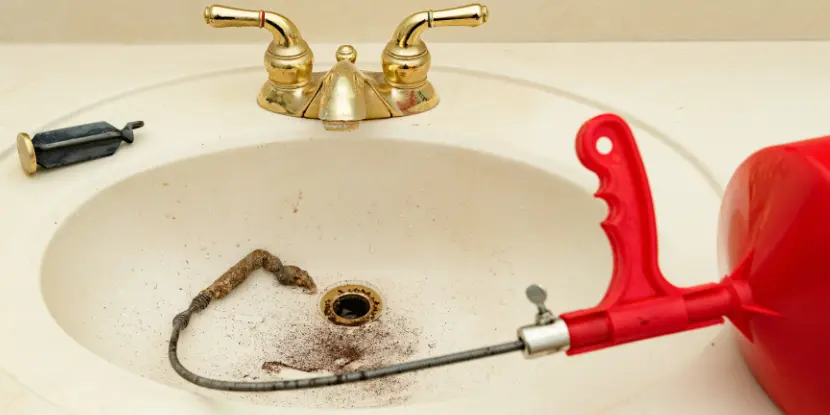
A plumbing snake for drains.
Essential Uses of a Drain Snake
- Clearing stubborn hair clogs deep within shower and bathtub drains
- Removing buildup or small objects stuck in bathroom sink drains
- Tackling tough kitchen sink clogs caused by food debris and grease
- Snaking through floor drains in basements or utility rooms
- Can be used as a preventive measure to keep drains clear and prevent future clogs
Toilet Auger
A toilet or closet auger physically removes clogs too stubborn for suction and pressure tactics. It has a long, flexible cable that snakes through the curves of the toilet trap. At the end of this cable is a corkscrew tip designed to break apart the clog or grab hold of it, allowing you to pull it out or push it down the pipe.
It’s specifically designed to unclog toilets without damaging the delicate porcelain. Its long, flexible shaft is encased in a tube to prevent scratches, and its curved tip is optimized to maneuver through the tight S-bend of a toilet.
Other Useful Tools & Equipment for DIY Projects
- Stud Finder: This helps you locate the wooden studs behind drywall, making hanging shelves or mounting TVs easier and more secure.
- Socket Set: A socket wrench set can save you time and effort when working with hex screws, bolts, or nuts.
- Caulking Gun: Use this to apply caulk around windows, tubs, showers, and countertops for a professional-looking finish.
- Safety Glasses: Protect your eyes from flying debris and harmful chemicals.
- Flashlight or Headlamp: Ensure proper lighting in dimly lit areas to avoid accidents or mistakes.
- Dust Mask: Keep dust, debris, and fumes from entering your lungs while working with power tools or in dusty environments.
- Heavy-Duty Extension Cord: Essential to power tools and equipment in projects requiring outdoor or distant power sources.

Locating a stud with a stud finder.
Organization & Storage Solutions
Keep your tools neat, organized, and easily accessible with these storage solutions.
- Tool Belt or Apron: Wear this to store frequently used tools while working on projects
- Toolbox: Choose one with multiple compartments and sections to store and organize your tools.
- Pegboard: Mount this on a wall and use hooks to hang your tools for easy viewing and access.
- Tool Bag: For carrying tools while working on projects or transporting them between locations.
- Shelving Unit: A permanent storage solution for larger tools or equipment in your garage, workshop, or shed.
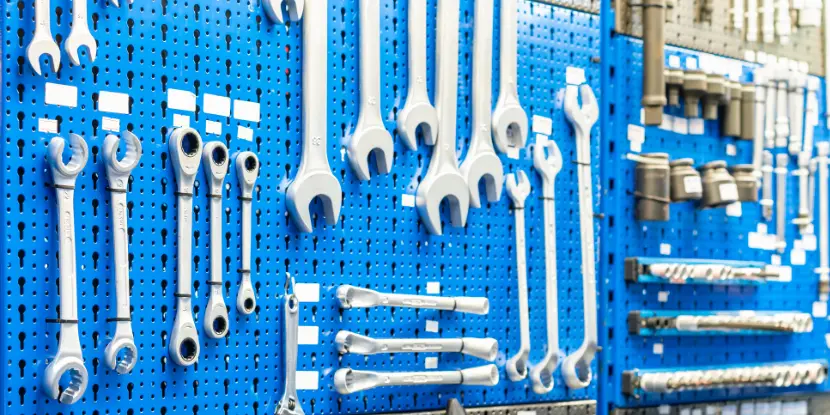
A pegboard for organizing tools.
FAQs: Tools for a DIY Tool Kit
Q: What if I don’t know how to use a particular tool?
YouTube, baby! And don’t be afraid to ask for help!
Q: How do I know when a project is too big to handle on my own?
Start small and gradually work your way up to more complex projects. If unsure, consult a professional or seek guidance from online tutorials and resources.
Q: Can I use power tools if I’m not experienced with them?
Maybe. Proceed with caution. Power tools can also be dangerous if not used correctly. Always read the instructions and take appropriate safety precautions.
Q: What should I do if I encounter unexpected problems during a DIY project?
Stay calm and assess the situation. Reach out to more experienced DIYers for advice, or consider hiring a professional if the problem seems beyond your expertise.
Q: How can I keep my tools in good condition?
Practice regular cleaning, proper storage, and occasional oiling or sharpening, where applicable. Always wipe down your tools after use to remove debris and moisture, which can lead to rust or deterioration.
Q: How do I choose the right screw or nail for a project?
Consider the materials you are joining and the load they’ll bear. For heavier loads or structural projects, screws offer greater holding power. For projects where appearance matters, nails or finish screws may be preferable.
Q: Is it worth buying tools for a one-off project?
Evaluate the cost of hiring a professional versus buying the tool. If the tool costs less than hiring a pro, and you might use it again, it might be worth the investment. Otherwise, consider renting the tool.
Q: What’s the difference between a drill and an impact driver?
A drill is a versatile tool for drilling holes and driving screws. An impact driver provides higher torque with less effort, making it better for driving long screws or bolts.
Q: What safety gear should I have for most DIY projects?
In addition to safety glasses and dust masks, wear work gloves to protect against cuts and abrasions. Ear protection is crucial when operating loud power tools, and closed-toe shoes protect against foot injuries.
Q: Can I perform electrical or plumbing work as a DIYer?
Electrical and plumbing work often requires specialized knowledge, tools, and permits. Work done incorrectly can be dangerous and expensive. When in doubt, hire a professional.

